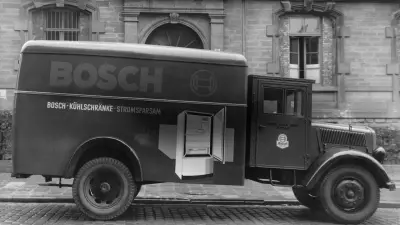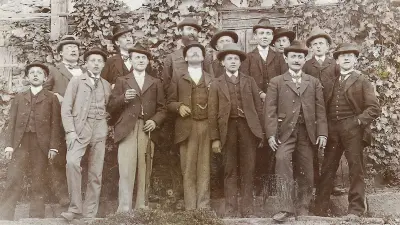Concise, clear, truthful. One century of the associate newspaper “Bosch-Zünder”
stories from the past and from the digital present

One hundred years of Bosch-Zünder, 893 issues, thousands of pages, millions of words about Bosch. And just a few words to do justice to it all? Best to make a best-of out of it. Let’s start with the most powerful sentence in the 100 years of Bosch-Zünder.

After searching old editions and thumbing through yellowed pages, we found the mother of all sentences, written in September 1946. Bosch-Zünder was back “after an involuntary break of two years,” albeit “temporarily as a publication of just two pages.” It is in this first issue after the second world war that we find the sentence destined to stop our browsing dead in its tracks: “Once again, Bosch-Zünder expresses the Bosch spirit of old: concise, clear, truthful.”
What a sentence – simple and elegant, yet so packed with meaning. On closer inspection, we see that it is more than just an announcement; it is also a statement of reckoning. On the one hand, our sentence of the century says that Bosch-Zünder is ready, following the dark days of the Third Reich, to take up its work again in the spirit of Robert Bosch, who never cared much for empty rhetoric. But at the same time, the sentence alludes to what Bosch-Zünder was not able to do under the pressure of the Nazi dictatorship: to always report concisely, clearly, and truthfully. They may be just a few words, but they separate journalism from propaganda.
This is also exactly what Robert Bosch meant when he wrote the foreword that appeared on the first page of the first issue of Bosch-Zünder – still the best editorial in 100 years of the publication’s history. Bosch-Zünder should, he said, “report on the facts” and enable the “level-headed evaluation of our common tasks” while “rejecting any bias.” This is still true today. In his wisdom, Robert Bosch also assumed a passive role: “We do not view the publication as a management newspaper. Instead, we hope for the active participation of our white-collar and blue-collar workers.”


He did not have to wait long for his dream of active participation to come true. Especially in the early days of the publication, many associates contributed articles to Bosch-Zünder. Let us take a look at a few issues from 1926. In them, we find not only long and relatively earnest editorials by the first editor in chief, Otto Debatin, on topics such as the stand-off in the class war, but also see that Debatin did not shy away from controversy. In the “Opinion” column, for example, he engaged in a heated debate with the works council on the topic of rationalization. Things got more entertaining whenever individual associates put pen to paper, which brings us to an essay entitled “Women and office work.” It wins the title of the most male-chauvinistic article in the pre-feminist era. The author − a man, naturally − believes that “women’s intrinsic dispositions mean that only a small percentage can derive a sense of satisfaction from office work.” Women are less capable of abstraction and concentration than men, he writes. As efficiency increases, however, it will be possible to reduce the amount of necessary human labor to such an extent “that women are no longer needed in industry or only to a minor degree,” he adds. “Nonetheless, there will still be plenty of other, truly feminine, duties for them to perform.” All too painfully, excerpts such as these illustrate why women’s liberation took so long, even at Bosch.
The birth of an idea
Ironically, many years later – decades later, in fact – it was to be a woman who would shake things up at Bosch-Zünder. In 1990, the contributor Marianne Waas-Frey visited the company’s locations in Brazil to research for a report. But while she may have been there to report on business in the country, she found she simply could not ignore the plight of the children in the favelas. Vividly, the reporter used the editorial conference to talk about what she had seen. Wolfgang Knellessen, the head of press and media relations at the time, listened intently to her stories. One thing led to another, and soon the idea of a donation campaign had been born. The idea met with unanimous approval, though a certain social romanticism may also have been at play. Today, however, we can say that it was the best editorial conference in 100 years of Bosch-Zünder. That is because the donation campaign would go on to become Primavera, an association of over 1,450 Bosch associates supporting some 19,000 children at Bosch locations in 17 countries. To date, it has collected nearly 10 million euros in donations for this cause. They say nothing is as old as yesterday’s news. But Bosch-Zünder’s Primavera concept has not aged.
International though the stories may have been in the 20th century, they were still only published in German. That did not change until 2005, when Bosch-Zünder was published in seven languages for associates across the globe for the first time – a multilingual concept that now runs to ten languages, and has received a number of awards. The team of writers has expanded its horizons past countries like Brazil to include even the most remote corners of the globalized world. “No competition within 3,700 kilometers”: written in 2013, this stark description of isolation kicks off a report from the “end of the earth” about Bosch Thermotechnology’s undisputed market leadership on Easter Island. This story from the middle of the Pacific Ocean also deserves a prize, as the most global one published in 100 years of Bosch-Zünder. The only thing that could top it would be a report from the moon.

From shadows into the light
Yet there are still good things to be found in our own backyard. One of the most exciting Bosch-Zünder stories originated just outside Stuttgart at the start of the 1990s – in a shunting locomotive chugging along the new high-speed rail line from tunnel to tunnel at no more than 45 kilometers per hour. Bosch engineers were spending night after night traveling by locomotive from one tunnel to the next to install a radio communications system. Work done in darkness, out of sight – that is what Bosch-Zünder still aims to bring to light after 100 years.

To this day, it is the in-depth reports from the working world that set the print edition of Bosch-Zünder apart. Today’s Zünder, now in magazine format, is published in a print-run of 200,000 four times a year, each issue dedicated to a special theme. And while the anniversary issue also celebrates the centennial landmark, its main concern is sustainability. And it is not just the board of management that has something to say on the subject, but no less a person than the climatologist Hans-Joachim Schellnhuber. This expands the horizon beyond Bosch, and helps the reader understand the reasons behind the company’s decision to make all its locations carbon neutral by 2020. In-depth reporting is one thing, yet the “concise, clear, truthful” ideal still remains. It is an ideal that is upheld today by formats such as BZ News. This weekly news summary is published at locations in 17 countries. Printed as a wall newspaper, it provides manufacturing associates with a brief update on latest developments at Bosch. But when it comes to delivering the very latest news, it is the company intranet that stands out. Short news items have been available online since 1997, making the publication a forerunner in digitalization. Since 2007, Bosch-Zünder Online has provided an up-to-the-minute platform on the intranet. In 2012, it became the landing page for associates across the globe. The news there is personalized according to operating unit, region, location, and reader interest. And since 2015, finally, Bosch associates worldwide have been able to keep up to date while on the move. There are now two Bosch-Zünder apps, which are avidly used by 35,000 associates. Robert Bosch’s newspaper now has a few digital sisters.
The spirit of the founder
This brings us full circle, back to the wish for “active participation of our white-collar and blue-collar workers,” expressed by Robert Bosch in the first ever issue of Bosch-Zünder. In today’s digital media, this translates into likes, shares, and comments. Every month, some 1,000 comments are published online, together with just under 3,000 likes. The speed and openness of Bosch-Zünder’s digital sisters is worthy of a story in its own right. The year is 2015, and Bosch has set its sights on the future of mobility – on electrified, automated, and connected driving. With a heavy heart, the board of management decides to part company with its long-established business with starter motors and generators – a business that, together with the entire workforce, will be sold to a Chinese automotive supplier two years later. Until that happens, however, passions run high, with nearly 2,000 digital comments. Bosch-Zünder takes advantage of the speed of its online format to publish Q&As and the latest news about demonstrations and works assemblies.
With so many changes, isn’t there also a need for a new spirit? This was the very question the editor in chief Jens-Peter Eichmeier asked the Bosch CEO Marcus Bierich in the early 1990s – incidentally, the first CEO interview in Bosch-Zünder. Bierich’s response is worth savoring: “No, there is no need for a new spirit at Bosch. We have the spirit handed down to us by our founder.” On this anniversary of Bosch-Zünder, we pay tribute to this sentiment.
Author: Ludger Meyer



